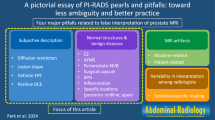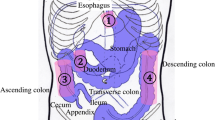Abstract
Purpose
The purpose of the study was to understand the effect of CT gantry speed and axial vs. helical scan mode on the frequency and severity of bowel peristalsis artifacts.
Method
We retrospectively identified 150 oncologic abdominopelvic CT scans obtained on a 256 slice CT scanner: 50 scans obtained with Axial mode and 0.5-s gantry rotation time (Slow-Axial); 50 with Axial mode and 0.28-s gantry rotation time (Fast-Axial); and 50 scans with Helical mode and 0.28-s gantry rotation time (Fast-Helical). The patients included 74 women and 76 men with a mean age of 61 years (range 22–85 years). Two readers viewed all CT scans to record the presence and severity of bowel peristalsis artifact, location of artifact (stomach, duodenum/jejunum, ileum, and colon) and artifact location relative to bowel interface (gas-bowel, fluid-bowel, and gas-fluid). The severity of artifacts was recorded subjectively on a 3-point scale, and objectively based on maximum length of the artifact.
Results
Peristalsis artifact was more commonly seen with Slow-Axial scan acquisition (37 of 50 patient scans, or 74%) than Fast-Axial (15 in 50 patient scans, or 30%, p < 0.001) and Fast-Helical (22 of 50 patient scans, or 44%, p < 0.005). The bowel segment distribution and severity of peristalsis artifacts were not significantly different between scan techniques.
Conclusion
Peristalsis artifacts are common at abdominopelvic CT scans. Fast gantry rotation speed significantly reduces the frequency of bowel peristalsis artifacts and should be a consideration when imaging of bowel and structures near bowel is critical.



Similar content being viewed by others
References
http://www.cdc.gov/nchs/fastats/leading-causes-of-death.html.
Pinto A, Brunese L (2010) Spectrum of diagnostic errors in radiology. World J Radiol 2(10):377–383
Busardo FP, et al. (2015) Errors and malpractice lawsuits in radiology: what the radiologist needs to know. Radiol Med 120(9):779–784
Beinfeld MT, Gazelle GS (2005) Diagnostic imaging costs: are they driving up the costs of hospital care? Radiology 235(3):934–939
Smith-Bindman R, Miglioretti DL, Larson EB (2008) Rising use of diagnostic medical imaging in a large integrated health system. Health Aff (Millwood) 27(6):1491–1502
Bradley D, Bradley KE (2014) The value of diagnostic medical imaging. North Carolina Med J 75(2):121–125
Abelson JA, et al. (2012) Evaluation of a metal artifact reduction technique in tonsillar cancer delineation. Pract Radiat Oncol 2(1):27–34
Barrett JF, Keat N (2004) Artifacts in CT: recognition and avoidance. Radiographics 24(6):1679–1691
Wilting JE, Timmer J (1999) Artefacts in spiral-CT images and their relation to pitch and subject morphology. Eur Radiol 9(2):316–322
Alfidi RJ, MacIntyre WJ, Haaga JR (1976) The effects of biological motion on CT resolution. Am J Roentgenol 127(1):11–15
Alfidi RJ, MacIntyre WJ, Haaga JR (1976) The effects of biological motion on CT resolution. AJR Am J Roentgenol 127(1):11–15
Chao-Kung Y, Orphanoudakis SC, Strohbehn JW (1982) A simulation study of motion artefacts in computed tomography. Physics in Medicine & Biology 27(1):51
Dosda R, et al. (2003) Effect of subcutaneous butylscopolamine administration in the reduction of peristaltic artifacts in 1.5-T MR fast abdominal examinations. Eur Radiol 13(2):294–298
Winklhofer S, et al. (2016) Reduction of peristalsis-related gastrointestinal streak artifacts with dual-energy CT: a patient and phantom study. Abdom Radiol (New York) 41(8):1456–1465
Yu H, Wang G (2007) Data consistency based rigid motion artifact reduction in fan-beam CT. IEEE Trans Med Imaging 26(2):249–260
Dhanantwari AC, Stergiopoulos S, Iakovidis I (2001) Correcting organ motion artifacts in x-ray CT medical imaging systems by adaptive processing. I Theory Med Phys 28(8):1562–1576
Rit S, et al. (2009) On-the-fly motion-compensated cone-beam CT using an a priori model of the respiratory motion. Med Phys 36(6):2283–2296
Leschka S, et al. (2009) Diagnostic accuracy of high-pitch dual-source CT for the assessment of coronary stenoses: first experience. Eur Radiol 19(12):2896–2903
Mahabadi AA, et al. (2010) Safety, efficacy, and indications of beta-adrenergic receptor blockade to reduce heart rate prior to coronary CT angiography. Radiology 257(3):614–623
Landis JR, Koch GG (1977) The measurement of observer agreement for categorical data. Biometrics 33(1):159–174
Fleischmann D, Boas FE (2011) Computed tomography–old ideas and new technology. Eur Radiol 21(3):510–517
Zerfowski D (1998) Motion artifact compensation in CT. In: Medical Imaging Proceedings SPIE 3338
Aschoff AJ, et al. (1999) Pancreas: does hyoscyamine butylbromide increase the diagnostic value of helical CT? Radiology 210(3):861–864
Rogalla P, et al. (2005) Spasmolysis at CT colonography: butyl scopolamine versus glucagon. Radiology 236(1):184–188
Kozak RI, et al. (1994) Reduction of bowel motion artifact during digital subtraction angiography: a comparison of hyoscine butylbromide and glucagon. Can Assoc Radiol J 45(3):209–211
Froehlich JM, et al. (2009) Aperistaltic effect of hyoscine N-butylbromide versus glucagon on the small bowel assessed by magnetic resonance imaging. Eur Radiol 19(6):1387–1393
Gutzeit A, et al. (2012) Evaluation of the anti-peristaltic effect of glucagon and hyoscine on the small bowel: comparison of intravenous and intramuscular drug administration. Eur Radiol 22(6):1186–1194
Acknowledgements
We would like to thank Jeremy Bancroft Brown MD-PhD candidate, UCSF for reviewing the early draft of our manuscript.
Author information
Authors and Affiliations
Corresponding author
Rights and permissions
About this article
Cite this article
Shah, R., Khoram, R., Lambert, J.W. et al. Effect of gantry rotation speed and scan mode on peristalsis motion artifact frequency and severity at abdominal CT. Abdom Radiol 43, 2239–2245 (2018). https://doi.org/10.1007/s00261-018-1497-0
Published:
Issue Date:
DOI: https://doi.org/10.1007/s00261-018-1497-0




